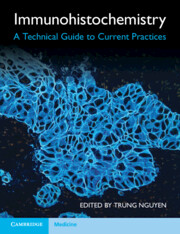Book contents
- Immunohistochemistry
- Immunohistochemistry
- Copyright page
- Dedication
- Contents
- Contributors
- Preface
- Chapter 1 Immunohistochemistry Fundamentals
- Chapter 2 Immunohistochemistry Quality Assurance and Quality Control
- Chapter 3 Automation and Robotics with the Leica Bond III
- Chapter 4 Automation and Robotics with the Roche Ventana BenchMark ULTRA
- Chapter 5 Automation and Robotics with the Agilent Dako Omnis
- Chapter 6 Immunohistochemistry for Research Applications
- Chapter 7 Troubleshooting Immunohistochemistry
- Chapter 8 Current Status of Immunohistochemistry
- Chapter 9 Immunohistochemistry for Future Applications
- Index
- References
Chapter 7 - Troubleshooting Immunohistochemistry
Published online by Cambridge University Press: 16 June 2022
- Immunohistochemistry
- Immunohistochemistry
- Copyright page
- Dedication
- Contents
- Contributors
- Preface
- Chapter 1 Immunohistochemistry Fundamentals
- Chapter 2 Immunohistochemistry Quality Assurance and Quality Control
- Chapter 3 Automation and Robotics with the Leica Bond III
- Chapter 4 Automation and Robotics with the Roche Ventana BenchMark ULTRA
- Chapter 5 Automation and Robotics with the Agilent Dako Omnis
- Chapter 6 Immunohistochemistry for Research Applications
- Chapter 7 Troubleshooting Immunohistochemistry
- Chapter 8 Current Status of Immunohistochemistry
- Chapter 9 Immunohistochemistry for Future Applications
- Index
- References
Summary
Immunohistochemistry assays can be technically difficult. There are countless opportunities for errors. Some faults can be fixed, and this chapter contains a precise appraisal of common problems encountered along with suggested solutions. Incorporating both pre-analytic conundrums and analytic challenges from a staining perspective, it is written by a medical scientist able to think outside the square and offer resolutions ranging from the practical to the unconventional. All prescribed advice has been tested and proven successful. Suggesting corrective actions is an exercise in giving the worker options and workarounds for certain situations. Doing more with less and less testing material and lifting sections from slides to be used again when the paraffin block is exhausted are two examples of what can be achieved. Ultimately, it is about tuning protocols to make the most of the precious test tissue given whilst eliminating unnecessary wastage.
- Type
- Chapter
- Information
- ImmunohistochemistryA Technical Guide to Current Practices, pp. 183 - 209Publisher: Cambridge University PressPrint publication year: 2022
References
- 1
- Cited by



